#sunskinks
Text
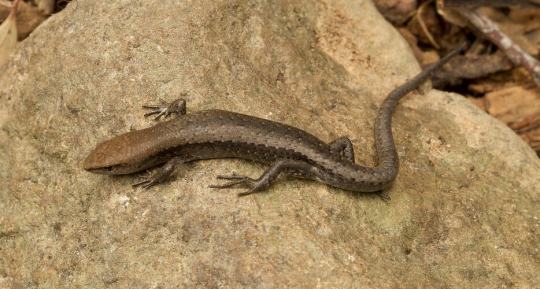
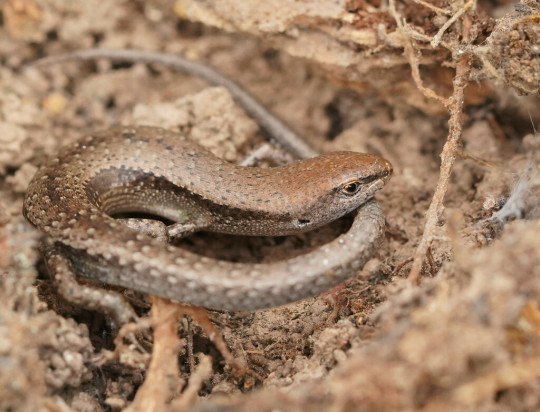
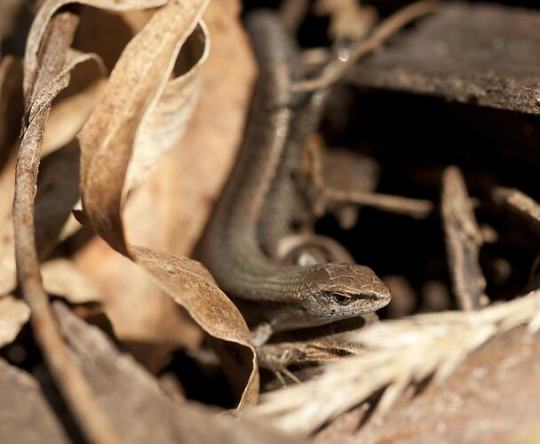
Lampropholis guichenoti, more popularly known as the grass skink, Guichenot's grass skink, the pale-flecked garden sunskink, or the penny lizard, is a small species of skink found throughout western and southern Australia. Its primary habitat is grasslands and scrublands with plenty of vegetative cover, though they are also a common sight in suburban backyards.
Though a nondescript brown, the penny lizard can be identified by a black stripe running the length of its body. Females can be distinguished by the light orange or reddish tint to their underbellies, while males are light grey. However, identifying the grass skink may prove difficult, as their small size makes them extremely good at hiding; on average an individual is only 8–10 cm (3.1–3.9 in) and weighs less than 2g (0.07 oz).
Male L. guichenoti are extremely terrirotial, and will fiercely defend their territory from other males- particularly in the spring. Breeding begins in September or October and continues throughout the summer. After mating, the female will lay about 2-6 eggs in a communal clutch alongside other females; in total these clutches can contain up to 250 eggs. These eggs hatch approximately 30 days to hatch, and young are fully independent upon emerging. On average, the grass skink can live for 2-3 years in the wild.
Because of their small size and lack of defensive systems, Guichenot's grass skink is an easy prey target for many species. Birds and feral cats are the primary predators, but the grass skink can also become a meal for larger lizards and snakes. The main way L. guichenoti avoids being lunch is by dropping its tail-- a common skink tactic. The tail continues to wriggle after being dropped, distracting the predator while the skink makes its escape and later regrows its tail. The penny lizard itself feeds mainly on small insects like crickets, isopods, earthworms, flies, and ants, as well as the occasional fruit or vegetable.
Conservation status: Lampropholis guichenoti has not been evaluated by the IUCN, but its population is generally considered to be large and stable.
If you like what I do, consider leaving a tip or buying me a kofi!
Photos
David Paul
Colin Silvey
Reiner Richter via iNaturalist
#grass skink#penny lizard#Squamata#Scincidae#sunskinks#skinks#lizards#squamates#reptiles#grasslands#grassland reptiles#scrubland#scrubland reptiles#urban fauna#urban reptiles#oceania#australia#south australia#west australia#animal facts#biology#zoology#ecology
65 notes
·
View notes
Photo
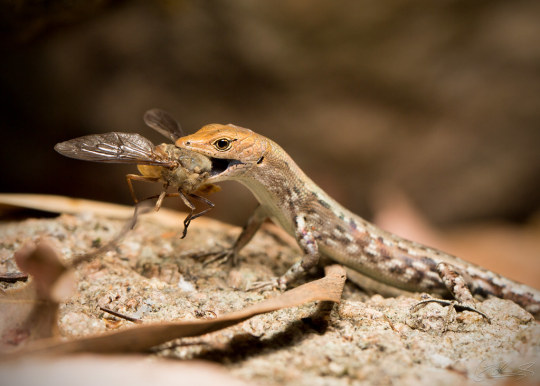
#saxicoline sunskink#Lampropholis mirabilis#horse fly#Tabanidae#Magnetic Island - Australia#predation
31 notes
·
View notes
Photo

common sun skink or as golden skink is one of reptile species Captured in cotigao wildlife sanctuary,Goa Special credit goes to @rajatsingh300 for identifying this beautiful reptile #sunskink #goldenskink #reptile #nikonasia #nikond3500photography #natgeoyourshot #naturephotography #natgeowild #natgeotravel #cotigaowildlife #cotigaowildlifesanctuary #goa (at Cotigao Wildlife Sanctuary) https://www.instagram.com/p/CJjAcPmDf5D/?igshid=1u8qq0q8isgu0
#sunskink#goldenskink#reptile#nikonasia#nikond3500photography#natgeoyourshot#naturephotography#natgeowild#natgeotravel#cotigaowildlife#cotigaowildlifesanctuary#goa
0 notes
Photo
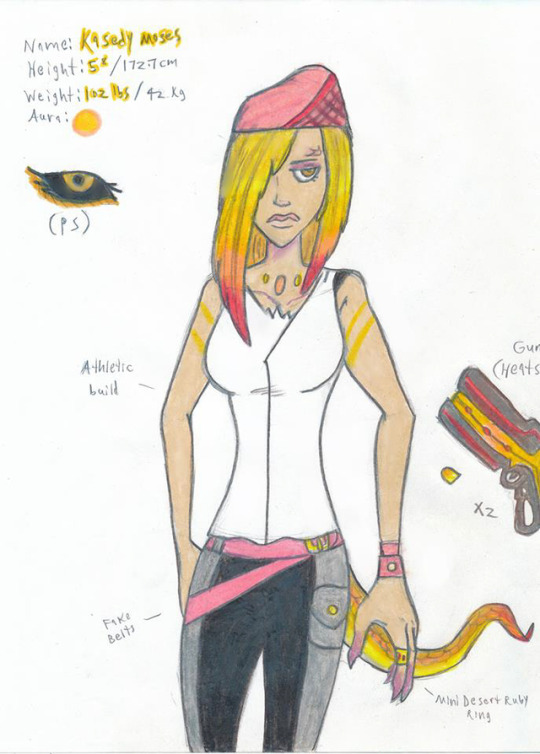
Kasedy, my sun skink/mango oc. From my project, Hybrid Theory.
0 notes
Text
Forest Fragmentation Disrupts Parasite Infection in Australian Lizards
Forest Fragmentation Disrupts Parasite Infection in Australian Lizards
In a study with implications for biodiversity and the spread of infectious diseases, CU Boulder ecologists have demonstrated that deforestation and habitat fragmentation can decrease transmission of a parasitic nematode in a particular species of Australian lizard, the pale-flecked garden sunskink.
The new experimental research, published today in the journal Ecology, found that specimens of…
View On WordPress
0 notes
Text
Forest fragmentation disrupts parasite infection in Australian lizards
In a study with implications for biodiversity and the spread of infectious diseases, ecologists have demonstrated that deforestation and habitat fragmentation can decrease transmission of a parasitic nematode in a particular species of Australian lizard, the pale-flecked garden sunskink.
Latest Science News -- ScienceDaily https://www.sciencedaily.com/releases/2018/11/181129084716.htm
0 notes
Text
Common Garden Skink – Ten Random Facts
Although small, common garden skinks are great garden helpers!
Common garden skinks are lizards native to forests, and grassy or woody habitats in southern and eastern Australia.
‘Common garden skinks’ are also known as ‘pale-flecked garden sunskinks’ and ‘garden skinks’.
The scientific name of a common garden skink is Lampropholis guichenoti, and it is from the family Scincidae, the family of skinks.
The colour of the skin of a common garden skink is mostly a brown-grey colour, and it usually has a black or dark coloured stripe down either side of its body and a copper coloured head.
The diet of common garden skinks generally consists of insects and vegetation, and can include caterpillars, spiders, slugs, cockroaches, crickets, worms and ants, and fruit and vegetables.
You're reading: Common Garden Skink – Ten Random Facts
Read more: 14 Vegetables to Grow In A Small Garden
Small and enclosed spaces, such as rocks or trees, are the sought after home for common garden skinks, and they are commonly found in urban gardens, hiding in among plants or leaves.
Common garden skinks generally grow to a length of 9 centimetres (3.5 inches), and they have five toes on each of their four legs, as well as a long tail.
Common garden skinks can release their tails when caught by predators, such as birds, cats and larger reptiles like snakes.
Female common garden skinks generally lay their small white eggs in a communal location, each contributing two to six eggs to the nest of up to 250 in total.
Common garden skinks have tiny teeth, and the lifespan of the reptile generally ranges from two to three years.
Bibliography:
Common Garden Skink, 2014, Wikipedia, https://ift.tt/3fDEGy8
Garden Skink, n.d, Museum Victoria, https://ift.tt/3AkZfHj
Lampropholis guichenoti, n.d, Lucid Key Server, https://ift.tt/3lHg9fm
Amazon:
Read more: How to make timber garden edging | Ways with wood
Source: https://livingcorner.com.au
Category: Garden
source https://livingcorner.com.au/common-garden-skink-ten-random-facts/
0 notes
Text
Amazing Facts about the Common Garden Skink | OneKindPlanet Animals
The Garden Skink is the most common skink found in suburban gardens around Victoria, Australia. It is found over most areas of the state except the semi arid northern and western regions. It lives in a variety of treed habitats.
You're reading: Amazing Facts about the Common Garden Skink | OneKindPlanet Animals
Read more: Small Holes In Yards – Tips For Identifying Holes Throughout The Lawn
Amazing Facts About the Common Garden Skink
The long body part of a skink looks more like a snake than a Lizard but they have very small legs and a head that is slightly off the ground and pointed upwards.
The Garden Skink usually has a browny black colour and sometimes may appear a dark shade of red when bathing in the sun.
The female Pale Flecked Garden Sunskink has a yellow, almost orange tinge to her underside, however the males have a light grey tinge to their underside.
They have no prominent teeth to harm larger predators, yet for smaller prey hold small, sharp teeth which can easily slice.
Garden skinks feed on larger invertebrates, including crickets, moths, slaters, earthworms, flies, grubs and caterpillars, grasshoppers, cockroaches, earwigs, slugs, small spiders, ladybirds, ants and many other small insects.
When hunting, the skinks will either hide and wait for prey to come by or actively pursue it (this depends on how hungry they are). Once they have caught their prey, they shake it around vigorously to kill it before swallowing it whole.
Skinks are often seen under leaves, in long grass and under rocks so that they can watch their prey, they also love hiding in logs where their big predators can’t get them.
As all reptiles are cold blooded, skinks can be seen on top of rocks or paths in the morning trying to warm their blood.
The Garden Skink’s predators are mainly birds. Even tiny birds like robins are a threat to skinks.
Like many other skinks, its tail will drop if grasped roughly. The disconnected tail will twitch vigorously for a while, capturing the attention of the predator while the lizard makes its escape. Although this may cost the skink some energy, the skink’s tail will eventually grow back.
The Common Garden Skink lays small, white eggs between summer and mid autumn. The female usually lays about four eggs, often in communal clutches that may contain as many as 250 eggs altogether, usually under a cluster of rocks to keep them safe from predators. The eggs hatch in a matter of weeks after they are laid.
Photo: www.animalstown.com
Read more: Best Vegetable Fertilizers w/ Chart
Source: https://livingcorner.com.au
Category: Garden
source https://livingcorner.com.au/amazing-facts-about-the-common-garden-skink-onekindplanet-animals/
0 notes